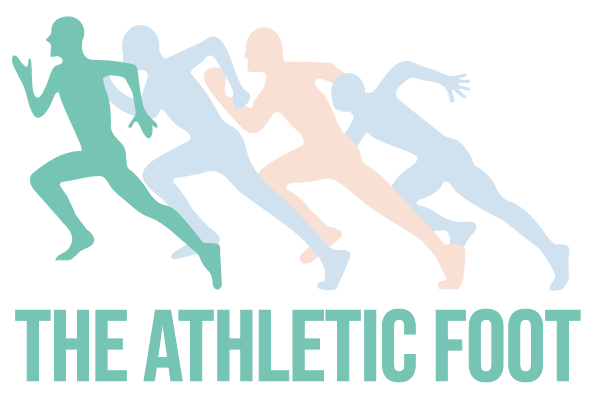For many runners, running equipment often extends beyond just simply shoes. For instance, socks, tights, and clothing can all drastically impact a runner’s performance and overall running experience. These items are designed specifically with the runner in mind and aim to provide certain enhancements to the runner such as UV protection and reduced muscle soreness.
One of the more popular items that many runners will seek out is headbands. Once thought of as a uniform essential of the uncool, more and more runners are opting for headbands because of their functionality and even fashion subscribing to the notion that what was once uncool is now cool.
We found that runners chose to utilize headbands for a variety of reasons that were specific to the individual. For instance, we found that one of the most common reasons runners turned to a headband was because of hair placement.
Running is a high impact movement and those with longer hair will typically find this experience uncomfortable without any restrictive assistance.
Additionally, long hair in windy conditions can impede visibility making it potentially unsafe. Lastly, free-flowing hair can itch in high impact activity making it more uncomfortable. As a result, many runners will use headbands to hold hair in place and out of the face during activity.
Because headbands are designed to tightly hug the runner’s head, even loose strands can be held in place quite effectively.

Another reason runners will use headbands is for sweat purposes. During high impact activity, runners can sweat anywhere from .8 to 1.4 liters. This can be exasperated when the runner has thicker hair, more prone to sweating, or live in warmer climates.
As a result, sweat can flow down the runner’s face causing hair or other debris to stick making for an uncomfortable running experience.
Additionally, sweat can penetrate a runner’s eyes which is both painful and impedes the runner’s vision making it also unsafe. Lastly, too much sweat can make for an uncomfortable experience during long distance runs.
As a result, runners will often utilize headbands to soak up the sweat during high impact activity.
Placed on the runner’s head, it prevents sweat from moving from the runner’s scalp to their face causing much of the issues outlined above. By having a headband soak up the sweat, runners can also stop from frequent pit stops to wipe sweat from their forehead and disrupting their rhythm.
Another reason runners will choose headbands is because of comfort. Headbands are typically tight or form fitting and as a result, closely hug the runner’s head. Other headbands can cover the runner’s ear to provide warmth during colder climate runs.
While for some, this may seem an uncomfortable instrument, for others, this is a comfortable feeling of security. During runs, it is important that runners are comfortable, which is why we stress runners should get properly fitted during runs for their shoes. Comfort can be the difference between personal record and underperformance.
Therefore, runners who like the compressive feeling of headbands find it to be comforting. While this benefit is completely mental, it is not too dissimilar from those who swear by compression gear or kinesiology tape to maximize performance.
For some runners, headbands are a key piece of performance related gear that is often non-negotiable.
Lastly, headbands are also a fashion statement for runners. Over the last few years, running shoe companies recognized that fashion was just as important to runners as function. As a result, running shoe companies would introduce shoes in vibrant, loud colorways or with equally eye-catching graphics.
Many runners feel that this look gives them an extra edge or at the very least makes running a more fun experience. Headbands introduce another element of fashion for runners looking to make a statement.
Like casual fashion, headbands were once thought to be uncool. However, they are now seen as funky or hip and runners who wear them for fashion feel empowered by the statement.
This was also helped with the popularity of headbands in other sports such as tennis and basketball where headbands are seen on the heads of the world’s best athletes.
Companies have recognized this love affair with headbands and have dedicated entire lines to creating fashionable, performance-ready headwear adorned by the company’s graphics and vibrant designs.
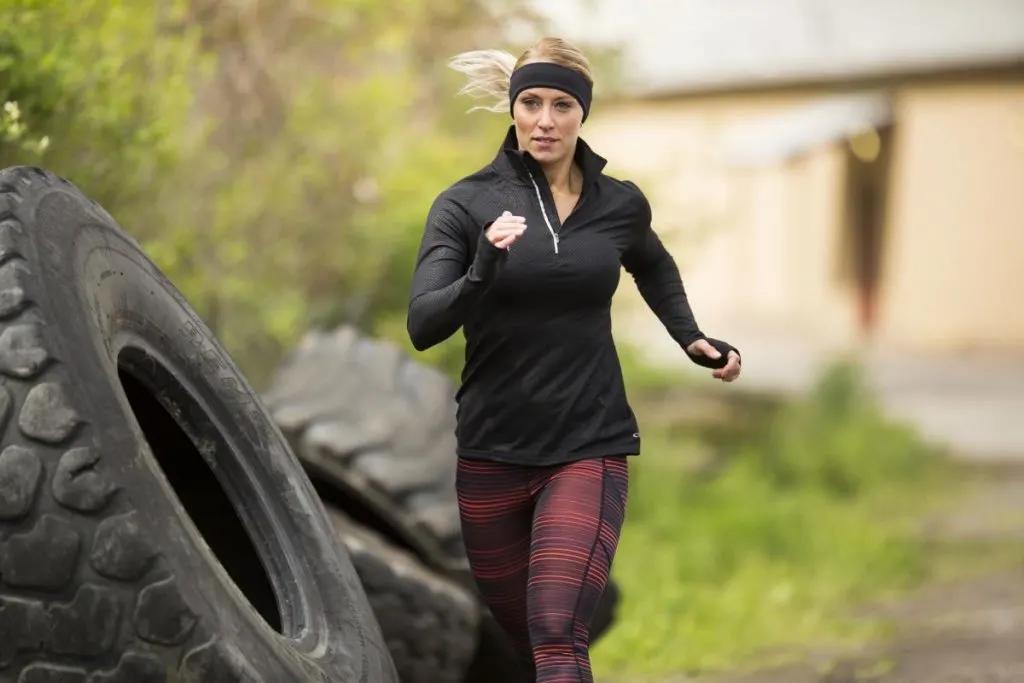
However, not all hairbands are created equally. While many once thought that all headbands were made from itchy, thick material popularized by the 1980’s, headbands now are available in smooth performance ready designs that are meant to look, feel, and perform cool.
With that in mind, we recommend runners consider the following when considering how to pick the best headband for running.
- Material
- Thickness
- Durability (washing)
- Aesthetic
Contents
Material
While headbands were once made purely from dense, heavier cotton fabrics, headbands now are designed with a number of different materials with a number of use case scenarios.
Therefore, like running shoes, it is equally important that runners carefully consider how they will be using the headband and what their specific use needs will be.
Thickness
The thickness of a headband can be the difference between comfort, functionality, and utility. Depending on the runner’s needs (warmth v. speed), different headbands with varying degrees of thickness will be appropriate for different circumstances. The thickness of the headband will also be crucial to the performance needs of the runner.
For instance, thinner headbands may be more suitable for speed or agility work while thicker headbands may be more important for simultaneously keeping hair out of the runner’s face while also soaking up the sweat.
Durability
Like any piece of running equipment, durability is a key consideration for running headbands. Running can be an intense experience and runners’ expectations of their respective equipment is that they will be able to withstand high usage and in some cases abusive treatment.
With headbands, runners expect that taking them on and off constantly will not stretch them. Throwing them into gym bags, pockets, or just carrying them should not compromise the integrity of the headband.
And friction and sweat should not cause excessive wear holes or tears. Finally, because headbands are essentially clothing such as running tights, runners expect that headbands would be able to withstand multiple washing and drying cycles.
Aesthetic
For the fashion interested, the branding and look of headbands are equally important. If a runner feels that the headband does not match with not only their personality but running style than the headband is mostly a distraction.
However, proper branding and look of a headband can empower runners and give them enough of a boost to run an extra mile or break a personal record.
With these four pieces of criteria in mind, we evaluate the most popular types of headbands below taking into consideration each of these four elements to consider when choosing the best headband for running.
Traditional Cloth Headbands
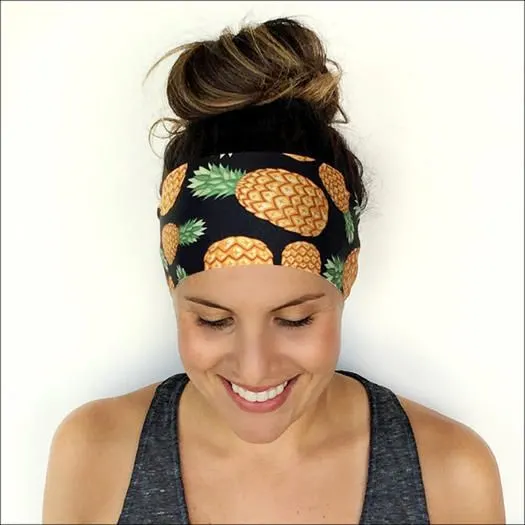
Material
Traditional headbands mostly popularized by movies are what most people think of when they think of headbands. These thicker pieces of fabric are traditionally offered in single colors and do a good job of soaking large amounts of sweat.
They are often made from terrycloth or another thicker cotton material. Additionally, terry cloth headbands tend to be both soft and extremely comfortable. As a result, we found that these are often the main headband of choice for those engaging in short periods of intense, high impact activity.
Examples of these include any sweatband that can be purchased in discount stores or in other specialty stores as well.
Thickness
Because of soaking up sweat is the main goal of these headbands, they tend to be thicker both in width and volume as well. Thinner headbands do not do as an effective job in soaking up sweat and as a result these headbands are made to soak up large amounts of sweat while staying on the runner’s head through the activity.
For those in warmer climates, these types of headbands may seem suffocating or uncomfortable. However, those running in colder climates or in indoor gyms, these headbands are ideal for short periods of activity and many find that the thickness helps in both keeping hair out of their face and soaking up sweat given their thickness.
Durability
Since these headbands tend to be of the cheaper variety, durability always fluctuates with traditional cloth headbands. First, the material in these headbands can tend to pill up after multiple washings.
Over long periods of time, this can cause a scratchy feeling on the runner’s head and make for an uncomfortable running experience. Additionally, these headbands can often suffer from losing its shape after repeated wear.
These headbands are typically made from elastic material that provides the stretchiness and flexibility. After long periods of time, this can become compromised and lose its shape and thus reducing its overall effectiveness. Lastly, because the headband is made of a cloth shell, these headbands can suffer from wear holes or various tears.
Repairing these headbands is possible, but because of the cheap cost, we found that many runners will simply replace them.
Aesthetic
Of all the types of headbands, we found this version to be the most aesthetically pleasing. These headbands can be had in a variety of bright colors. Additionally, the cost of these headbands is insufficient enough that buying a few different color options is a possibility.
Additionally, companies can easily brand these headbands easily with their logo or other design elements. For instance, the National Basketball Association makes popular headbands with their logo on the exterior.
Lastly, these headbands are a nod (or holdover) from previous eras and we find that runners enjoy the throwback element of these headbands.
Plastic
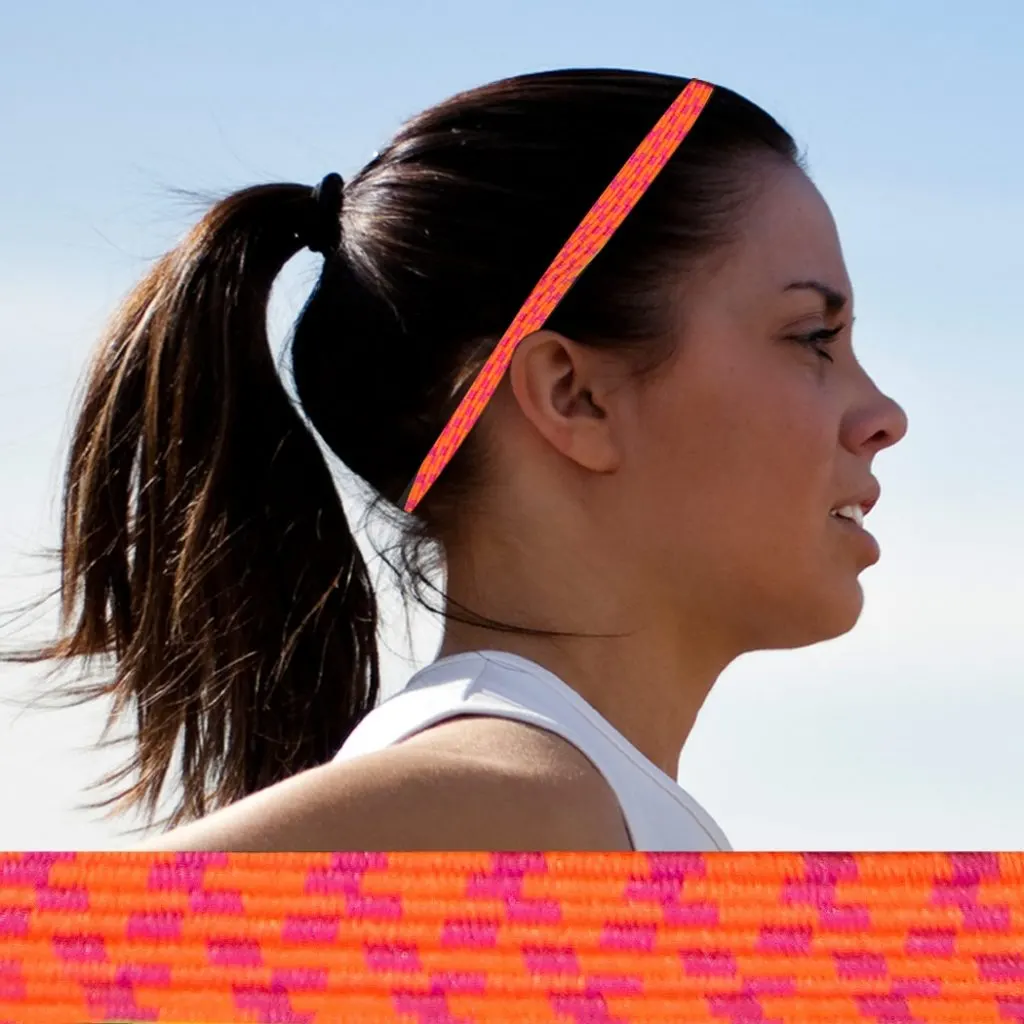
Material
Of all the types of headbands, these are the most durable of the group. Plastic headbands are simply made from plastic formed to mimic the shape of the runner’s head. For added comfort and performance, these headbands will typically feature rubberized tips to keep the plastic from scratching the runner’s head during movement.
These headbands are typically rigid with enough give to form to the runner’s head. The material is also naturally sweat resistant which keeps them from needing too much care over long periods of time.
These types of headbands are ideal for those looking to remove hair from their face and do not need too much sweat absorbing.
Thickness
Plastic headbands are normally made, on purpose, to be thinner and discrete. Because they are meant purely to keep hair from affecting the runner’s performance, they will typically get buried in the runner’s head and hair.
To keep them from being obtrusive, these headbands are thin and inconspicuous. Because they are plastic, they do not need to be extra thick since it already does a good job of holding hair in its place.
Also since these headbands are not designed to absorb sweat, they are not thick or overly complicated.
Durability
Plastic headbands generally do a good job of holding its shape over long periods of time. Because they are rigid with minimal flex so that they can get on the runner’s head, there is not a lot of care necessary.
Runners will not have to worry about stretching plastic headbands beyond wear and compromising their fit. Runners will also not have to worry about it losing its sweat absorbing properties or having to worry about it in the wash.
However, because it is plastic, these headbands will be subject to snapping or cracking in certain places and we found that the sweat and salt from runners could compromise the integrity of the plastic headband over time.
Aesthetic
While these headbands are the easiest in terms of care and material, they are also the least pleasing for aesthetic purposes. While some companies can offer bright colors for plastic headbands, because they tend to get buried in the runner’s hair, it is often difficult to wear plastic headbands as a fashion statement or empowering running armor.
These plastic headbands are also the most boring of the group since they prioritize function over fashion as well.
Quick dry fabrics
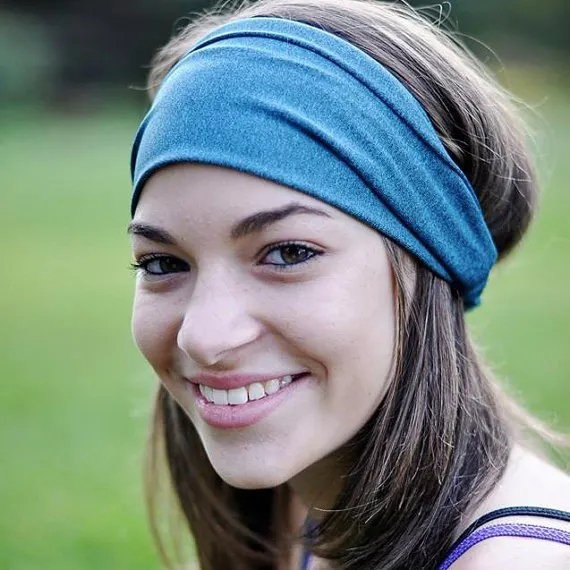
Material
Of all the types of headbands, quick-dry fabrics are the most technologically advanced. These headbands are typically made of quick-dry fabrics, which is usually a combination of nylon and polyester. Additionally, companies can manipulate these fabrics based on the need of the runner.
For instance, some companies add in thermal pads to keep the runner warm during colder runs. Others will add more reflective material to keep the runner safe during evening runs or during times with low visibility.
Thickness
Quick dry fabrics are attractive because of their ability to do a lot with little fabric. As a result, these are often thinner than traditional cotton fiber headbands. Often companies can achieve much of their intended aims with a simple thin piece of fabric.
As a result, runners do not have to worry about taking up too much space with these headbands or overheating in certain environments.
Durability
Quick dry fabric headbands tend to be inherently stretchy and flexible and does a good job of returning to shape without much care. While improper care such as drying on high heat settings will compromise this quality, most quick dry fabric headbands maintain their elasticity over long periods.
However, because these headbands tend to be thinner, runners often have to be cautious not to expose them to harsh exterior structures such as concrete as they can be susceptible to holes or wear.
Aesthetic
Companies tend to love quick dry fabric headbands because it really allows them a creative space to design. These materials take well to graphics and design allowing runners to choose their headband based on their personality or running style.
These quick dry fabric often display the companies’ logo prominently and can be designed in a number of different styles. As a result, we find that most runners opt for these types of headbands when looking for both performance and fashion as well.
- Spartan Race vs Tough Mudder Compared – Which Obstacle Race is Better? - January 22, 2022
- Brooks Addiction Walker vs New Balance 928: Which is Best? - December 7, 2021
- Brooks Ravenna vs Adrenaline – Which is Best for You? - December 4, 2021
